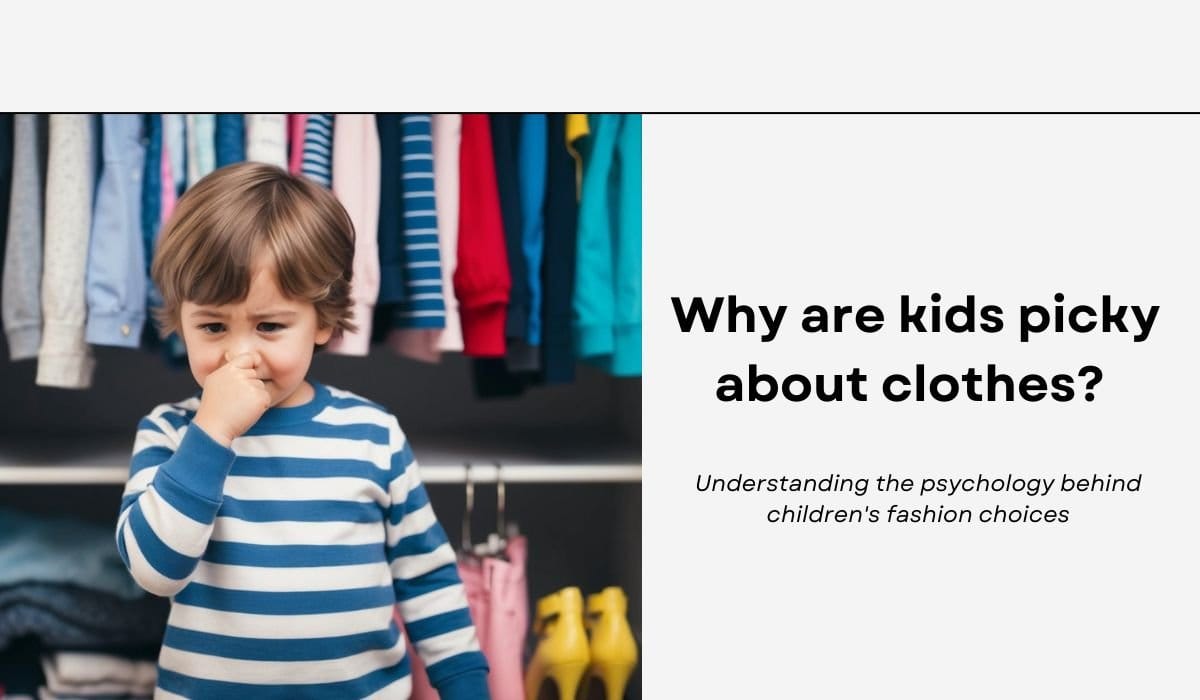The Hidden Reasons Behind Your Child’s Daily Clothing Battles
Many children are picky about the clothes they wear. This can be frustrating for parents who struggle to get their kids dressed each morning. Kids may be fussy about clothing due to sensory issues, where certain fabrics or textures feel uncomfortable or even painful against their skin.
Some children have heightened sensitivity to tactile sensations, making them more aware of how clothes feel. They might complain about scratchy tags, tight waistbands, or seams that rub. Other kids may dislike certain smells or the way some clothes look on them.
Clothing preferences can also be linked to a child’s need for control or desire to express themselves. As children grow and develop their own tastes, they may become more vocal about what they want to wear. Understanding the reasons behind a child’s clothing choices can help parents find solutions that work for everyone.
On This Page
Key Takeaways
- Children may be picky about clothes due to sensory sensitivities or a need for control
- Certain fabrics, textures, and features like tags or seams can cause discomfort
- Understanding a child’s clothing preferences can help find suitable options
Understanding Sensory Processing Disorder
Some children struggle with clothes due to how their brains process sensory information. This can make certain fabrics or textures feel unbearable. Let’s explore the key aspects of this condition.
Defining Sensory Processing Disorder (SPD)
Sensory Processing Disorder is a condition where the brain has trouble receiving and responding to sensory information. Children with SPD may be overly sensitive to touch, sound, or other stimuli. This can make everyday activities challenging.
SPD affects how a child interacts with their environment. They might find certain clothing textures painful or irritating. Some common signs include:
- Refusing to wear certain fabrics
- Being bothered by tags or seams
- Disliking tight or loose clothing
SPD can vary in severity. Some children have mild symptoms, while others struggle more with daily tasks.
SPD and Autism Spectrum Disorder
SPD often occurs alongside Autism Spectrum Disorder. Many autistic children experience sensory sensitivities. This can make dressing a challenging task for both the child and parents.
In autism, sensory issues can be more pronounced. A child might:
- Have extreme reactions to certain fabrics
- Insist on wearing the same clothes repeatedly
- Struggle with changes in routine or clothing
It’s important to note that not all children with SPD have autism, and not all autistic children have SPD. However, the overlap is significant.
Tactile System and Sensory Sensitivity
The tactile system plays a crucial role in how we perceive touch. In children with sensory issues, this system can be overactive. This leads to heightened sensitivity to clothing textures.
Common tactile sensitivities include:
- Discomfort with scratchy fabrics
- Feeling overwhelmed by tight clothing
- Disliking certain textures against the skin
These sensitivities can make choosing clothes difficult. Parents may need to try different fabrics and styles to find what works best for their child.
Understanding these sensitivities helps in managing clothing issues. It allows parents and caregivers to create a more comfortable environment for the child.
Sensory Challenges and Clothing

Some children find certain clothes uncomfortable due to sensory issues. This can make getting dressed a daily struggle for both kids and parents.
Common Clothing Sensitivities
Many children with clothing sensitivity dislike specific fabrics, textures, or features. Scratchy tags, tight elastic, and stiff denim often cause problems. Seams in socks and underwear can feel very irritating.
Some kids only tolerate soft, loose-fitting clothes. Others prefer tight, compressive garments. Preferences vary widely between children.
Common triggers include: • Itchy wool or synthetic fabrics • Stiff new clothes • Wrinkled or bunched-up fabric • Clothing labels and tags • Tight waistbands or cuffs
Sensory-friendly clothing options can help. These may have flat seams, no tags, and ultra-soft fabrics.
Tactile Defensiveness and Clothing
Tactile defensiveness is when touch sensations feel unpleasant or overwhelming. For these children, clothing can be highly distressing.
They may refuse to wear certain items or have meltdowns when getting dressed. Even soft fabrics can feel scratchy or painful on their skin.
Strategies that can help include: • Letting the child choose their own clothes • Cutting out tags and labels • Washing new clothes to soften them • Layering comfortable undershirts • Using compression garments
Occupational therapy can also teach coping skills for clothing sensory issues. With patience and the right techniques, dressing struggles can improve over time.
Identifying Sensory Issues With Specific Clothing Items

Kids who are picky about clothes often have sensory issues with certain garment features. These can cause discomfort or even pain. Let’s look at some common trouble spots.
Socks and Seams
Many children struggle with socks and seams. The texture of socks can feel scratchy or too tight. Seams inside socks may rub against toes, causing irritation.
Some kids only tolerate seamless socks. Others prefer thick cushioned socks or very thin ones.
Seams in other clothing can also be bothersome. Shirt seams may feel rough on shoulders or sides. Trouser seams might chafe against legs.
Try turning socks and clothes inside out. This can reduce seam friction. Look for flat seam or seamless options when shopping.
Tags and Collars
Clothing tags and collars are often culprits for sensory discomfort. Tags can feel scratchy or pokey against skin. Some children find shirt collars too tight or irritating around the neck.
Removing tags is an easy fix. Many brands now offer tagless options. For collars, look for soft, stretchy fabrics. V-neck or scoop neck styles may be more comfortable than crew necks.
Some kids prefer tops without collars, like t-shirts. Others might tolerate collars better if they’re worn over an undershirt.
Waistbands and Buttons
Waistbands can cause issues for sensory-sensitive children. Tight or elastic waistbands may feel constricting. Some kids find the pressure uncomfortable or distracting.
Look for trousers with soft, stretchy waistbands. Drawstring options allow for adjustable fit. Some children prefer looser styles like joggers or leggings.
Buttons can be tricky too. They might feel hard or bumpy against skin. Zips can also be problematic. Consider clothes with alternative fastenings like velcro or snap buttons.
Shoes and Underwear
Shoes and underwear are often challenging for kids with sensory issues. Shoes may feel too tight, too loose, or have bothersome seams inside.
Look for shoes with minimal seams and soft linings. Some children prefer slip-on styles or shoes with velcro closures. Others might like the snug feel of high-top trainers.
For underwear, seamless options can help. Some kids prefer boxers or loose-fitting styles. Others might like the pressure of snug-fitting pants or vests.
Try different fabrics and fits to find what works best. Some children feel more comfortable in soft, stretchy underwear made from natural fibres.
The Role of Occupational Therapy

Occupational therapy can help children who struggle with clothing sensitivities. These specialists use specific techniques to address sensory issues and make dressing easier for kids and parents.
Working With an Occupational Therapist
An occupational therapist assesses a child’s sensory needs related to clothing. They look at how textures, tags, seams and other factors affect the child. The therapist creates a plan to gradually increase tolerance to different fabrics and clothing types.
Sessions may involve trying on various items in a low-pressure setting. The therapist teaches coping strategies to manage discomfort. They might suggest clothing modifications like removing tags or choosing softer fabrics.
Parents learn ways to support their child at home. This may include setting up a “clothing menu” with approved options. The therapist can advise on shopping for sensory-friendly clothes.
Occupational Therapy Techniques for Clothing
Occupational therapists use several methods to help children with clothing sensitivities:
- Desensitisation: Gradually exposing the child to different textures
- Deep pressure: Using firm touch to calm the nervous system
- Sensory diet: Activities that meet the child’s sensory needs
- Visual schedules: Breaking down dressing into manageable steps
They may introduce clothing-related games and activities. This helps children associate positive experiences with getting dressed.
Therapists might recommend tools like seamless socks or clothing with flat seams. They can teach children how to advocate for their sensory needs.
With consistent practice, many children learn to tolerate a wider range of clothing options.
Designing a Sensory-Friendly Wardrobe

Creating a sensory-friendly wardrobe involves careful fabric selection, essential clothing features, and special attention to socks and undergarments. These elements work together to ensure comfort for children with sensory sensitivities.
Choosing the Right Fabrics
Sensory-friendly clothing starts with selecting the right fabrics. Soft, smooth materials are key. Cotton, bamboo, and modal are excellent choices due to their natural softness and breathability.
Avoid scratchy textures like wool or certain synthetic blends. These can irritate sensitive skin. Stretchy fabrics like jersey knits or elastane blends offer flexibility and comfort.
Look for lightweight options that don’t feel heavy on the body. Layering thin, soft fabrics can provide warmth without bulk.
Essential Features of Sensory-Friendly Clothing
Sensory-friendly garments have specific design elements. Tagless clothing is crucial, as tags can be a major source of irritation. Flat seams or seamless construction reduce friction against the skin.
Loose-fitting styles allow for easy movement and less skin contact. Adjustable waistbands and cuffs offer customisable comfort. Avoid tight elastics or constrictive areas.
Soft, wide necklines prevent throat discomfort. Consider clothing with minimal embellishments or decorations that might feel bumpy or rough.
Sensory-Friendly Socks and Undergarments
Socks and undergarments are crucial in a sensory-friendly wardrobe. Seamless socks prevent toe irritation and bunching. Look for options with smooth toe seams or no seams at all.
For undergarments, choose soft, breathable fabrics without scratchy lace or trims. Wider waistbands and leg openings reduce pressure points.
Consider moisture-wicking materials to keep skin dry and comfortable. Seamless or flat-seam underwear can prevent chafing and discomfort.
Managing and Preventing Sensory Meltdowns

Sensory meltdowns can be overwhelming for children with sensory processing challenges. There are ways to avoid dressing difficulties and help kids cope when meltdowns occur.
Strategies to Avoid Dressing Difficulties
To prevent sensory meltdowns related to clothing, parents can take proactive steps. Remove clothing tags and choose soft fabrics without scratchy seams. Let children pick their outfits when possible to give them control.
Shop for clothes together and have kids try things on before buying. Look for clothing red flags like tight waistbands or itchy materials. Dress in layers so kids can adjust for comfort.
Establish a consistent dressing routine. Use visual schedules to make the process predictable. Give extra time in the morning to avoid rush and stress.
Coping Mechanisms During Meltdowns
When a sensory meltdown occurs, stay calm and provide a quiet space. Use a gentle voice and avoid physical touch unless the child seeks it. Offer comfort items like a favourite soft toy or blanket.
Deep pressure can be soothing. Try weighted blankets or tight hugs if the child allows. Encourage deep breathing or counting exercises to help regain control.
After the meltdown, talk about what happened. Help the child identify triggers and brainstorm solutions together. Consider keeping a log to spot patterns in meltdown causes.
Praise the child for calming down. With patience and practice, kids can learn to manage sensory challenges over time.
Incorporating Sensory Play and Therapy
Sensory play and therapy can help children who struggle with clothing sensitivities. These approaches provide safe ways for kids to explore different textures and sensations.
Benefits of Messy Play
Messy play lets children touch and feel various materials in a fun setting. This can help reduce tactile defensiveness. Activities like playing with sand, slime, or finger paints expose kids to new textures.
Messy play also builds fine motor skills. Squishing dough or moulding clay strengthens hand muscles. This can make it easier to do up buttons or zips on clothes.
Some messy play ideas include:
- Making mud pies
- Finger painting
- Playing with shaving foam
- Exploring a sensory bin filled with dried beans
Therapeutic Interventions
Occupational therapists can help children with sensory issues related to clothing. They may use a ‘sensory diet’ – a planned set of activities that provide sensory input throughout the day.
Deep pressure activities can be calming for some children. These might include:
- Using a weighted blanket
- Getting tight hugs
- Rolling up in a yoga mat
Brushing therapy is another technique. It involves brushing the skin with a soft brush in a specific pattern. This can help desensitise the tactile system over time.
Supporting Children With ADHD and Tactile Sensitivity
Children with ADHD often struggle with sensory processing issues, especially tactile sensitivity. This can make everyday tasks like getting dressed challenging. There are ways to help these children cope and thrive.
Understanding the Relationship Between ADHD and Sensory Processing Issues
ADHD and sensory processing issues often go hand in hand. Many children with ADHD have tactile sensitivities that affect their daily lives. They may find certain textures unbearable or react strongly to light touch.
Common triggers include: • Tight or itchy clothing • Tags in clothes • Seams in socks • Certain fabric textures
These sensitivities can lead to meltdowns or refusal to wear certain items. It’s important to recognise that these reactions stem from genuine discomfort, not defiance.
Adaptive Techniques for Children With ADHD
There are several strategies to help children with ADHD and tactile sensitivity:
- Choose comfortable clothing: Opt for soft, seamless items without tags.
- Allow choices: Let the child pick their clothes when possible.
- Use visual schedules: This can help with the dressing routine.
- Gradual exposure: Slowly introduce new textures in a low-stress environment.
- Sensory breaks: Provide time for calming activities throughout the day.
Occupational therapy can be helpful. Therapists can work on desensitisation techniques and provide tools to manage sensory overload.
Remember, each child is unique. What works for one may not work for another. Patience and understanding are key in supporting these children.
Frequently Asked Questions
Children’s clothing preferences can stem from various factors. These include sensory sensitivities, developmental stages, and individual comfort levels. Let’s explore some common questions parents have about their children’s clothing choices.
What causes some children to have sensory issues with clothing?
Sensory issues with clothing often relate to how a child’s brain processes touch information. Some kids have tactile hypersensitivities, making certain fabrics feel uncomfortable or even painful.
This can cause them to be very picky about what they wear. Rough textures, tight fits, or scratchy tags might bother them more than other children.
Can clothing sensitivity be an indicator of autism in children?
Clothing sensitivity can be a sign of autism, but it’s not a definitive indicator on its own. Many autistic children experience sensory sensitivities, including issues with clothing.
These sensitivities might lead to preferences for certain fabrics or fits. However, it’s important to note that not all children with clothing sensitivities are autistic.
Why does my child have such particular preferences when choosing clothes?
Children’s clothing preferences can stem from various factors. These might include sensory sensitivities, personal style, temperature regulation, or a desire for independence.
As children grow, they start to form their own opinions about what they like to wear. This is a normal part of development and self-expression.
How are sensory issues linked to ADHD affecting a child’s choice in attire?
ADHD can be associated with sensory processing difficulties, which may impact clothing choices. Children with ADHD might be more sensitive to certain fabrics or fits.
They might struggle with clothes that feel too tight, loose, or have irritating tags. These sensitivities can make getting dressed a challenging task.
In what ways can I accommodate my child’s aversion to getting dressed?
To help a child who dislikes getting dressed, try to make the process more comfortable. Offer loose-fitting clothes and soft fabrics.
Remove itchy tags and let your child choose their outfits. Creating a calm environment and allowing extra time can also help reduce stress.
What strategies can I use to handle my child’s distaste for wearing certain clothes?
To manage clothing preferences, involve your child in the shopping process. Let them touch fabrics and choose items they like.
Consider sensory-friendly clothing brands. Gradually introduce new textures and styles. Be patient and understanding, as forcing uncomfortable clothes can lead to more resistance.
Related Post: How Often Should You Buy Kids’ Clothes? A Practical Guide for Parents

